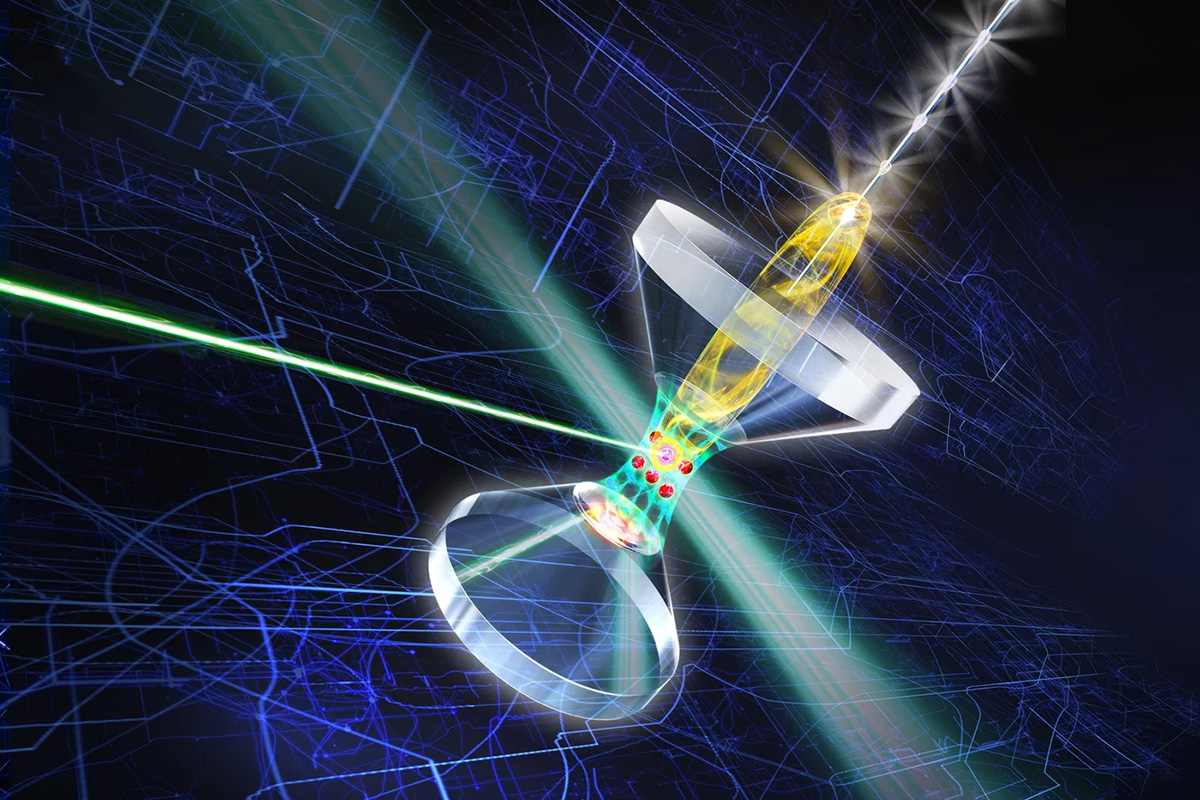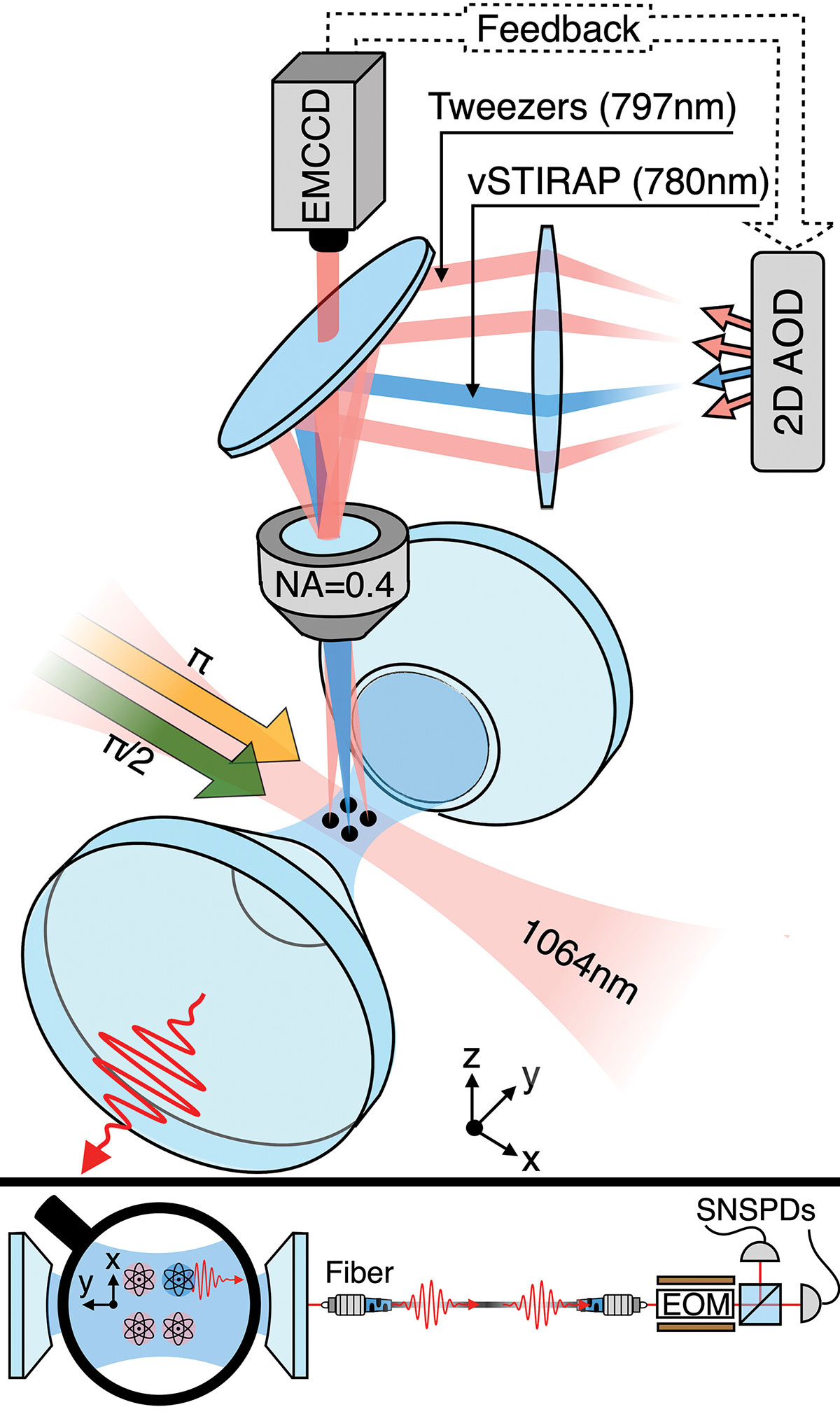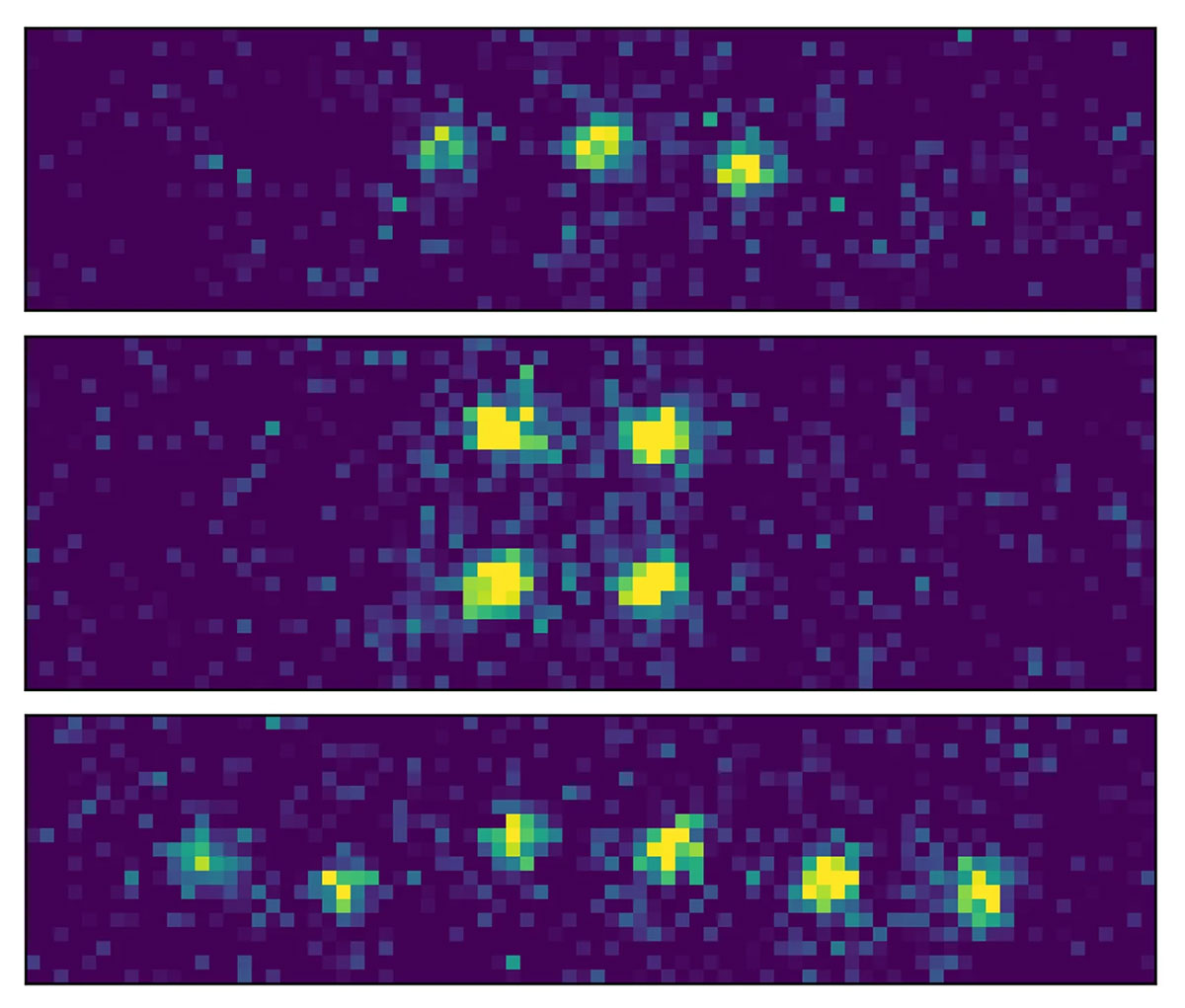Researchers at the Max Planck Institute of Quantum Optics (MPQ) have shown how optical tweezers can be used to set up rubidium atoms in an optical cavity, creating a “quantum network register” for high-efficiency atom-photon entanglement. [Image: MPQ]
Realizing secure quantum networks, as well as some distributed architectures for more powerful quantum computing, rests on the search for reliable “quantum repeaters.” These are devices that can transfer delicate quantum information zipping along in photons—“flying” qubits (quantum bits)—to temporary storage and manipulation in “resting” qubits such as fixed atoms or ions. The information is then passed back to fresh photons, like fresh horses in a relay team, to continue the journey to the next node in the quantum network.
Such systems require entanglement between photons and atoms. And, as always, the trick is to coax entanglement, an inherently probabilistic process, into becoming deterministic—or very nearly so.
In an experimental tour-de-force, a team from the Max Planck Institute of Quantum Optics (MPQ), Germany, has used a combination of cavity quantum electrodynamics and optical trapping to create a “quantum network register” that approaches just that kind of reliability (Science, doi: 10.1126/science.ado6471). By cleverly arranging the system geometry, the team was able to set up and tightly localize arrays of up to six rubidium atoms in an optical cavity using optical tweezers, and couple them to a communication channel for carrying their quantum information away as entangled photons.
The team was able to achieve atom-photon entanglement with a probability as high as 97% per attempt—approaching entanglement at “the push of a button.”
Taking advantage of the multiplexing opportunities afforded by such a multi-atom quantum memory register, the team was able to achieve atom-photon entanglement with a probability as high as 97% per attempt—approaching entanglement at “the push of a button.”
Tweezers plus cavity
In a previous 2021 study in Physical Review Letters, the MPQ team behind the new work, led by Gerhard Rempe, had already demonstrated a quantum repeater node consisting of two atoms trapped in an optical cavity. But the team wanted to see if it could get past some of that system’s shortcomings—especially its “rather inefficient probabilistic loading”—and reach a more deterministic quantum register.
Top: Schematic view of experimental setup. Bottom: the signal photon passes through one side of the resonator into an optical fiber for measurement of entanglement parameters. [Image: Reprinted with permission from L. Hartung et al., Science 385, 179 (2024); doi: 10.1126/science.ado6471]
To do so, the researchers first set up a Fabry-Pérot cavity consisting of two resonator mirrors spaced “only about half a millimeter apart,” according to the paper’s first author, MPQ Ph.D. student Lukas Hartung. Positioned above the resonator, at a right angle to it, was a microscope objective, to serve as the vehicle for the optical tweezers, and an electron-multiplying CCD (EMCCD) camera, to record the atom positions within the cavity.
Next, the researchers transferred rubidium atoms that had been cooled and captured in a magneto-optical trap into the center of the Fabry-Pérot cavity. During the atom transfer, they switched on the laser array for the tweezers, sending the light through the microscope objective and controlling the tweezers using 2D acousto-optic deflectors (AODs). As the tweezers herded the rubidium atoms within the cavity, the EMCCD camera captured scattered light from the atoms, allowing the team to image the atoms in real time and to refine their position still further using the tweezers, moving the atoms into ordered arrays within the cavity.
Once the atoms had been placed in the right positions using the tweezers, the team made the confinement more robust by transferring the atoms into a 2D optical lattice, consisting of a red-detuned standing-wave trap orthogonal to the cavity and a blue-detuned standing-wave trap within the cavity. This set the atoms up to serve as a quantum memory register of tightly positioned matter qubits.
Measuring entanglement
With the quantum register in place, the team set about acting on it to determine its effectiveness for atom-photon entanglement. The team used an optical-pumping process called vacuum-stimulated Raman adiabatic passage (vSTIRAP) to manipulate the quantum state of the atoms. In this process, the atoms are illuminated, one after the other, with polarized light. The cavity resonance is set such that it stimulates Raman scattering of a signal photon and transfers the target atom into one of two quantum states, depending on the photon polarization. The signal photon and the atom thus should be in an entangled state.
In the final stage of the experiment, the signal photon passes out of one end of the resonator cavity and is coupled into optical fiber, where it proceeds to a detector consisting of an electro-optic modulator and single-photon detectors. The team can then assess the entanglement fidelity—how well entanglement is preserved between atom and photon across this particular channel—by measuring the correlations between the signal photon polarization and the internal atomic states. The team also measured the efficiency of the system, the probability that a given atom would generate a corresponding entangled photon.
The virtues of multiplexing
The team’s optical-tweezers setup was able to arrange up to six atoms in a quantum register that could generate entanglement with a greater than 97% probability. [Image: MPQ]
The team found that the setup yielded an entanglement fidelity of around 87% for a single atom in the cavity, and that the fidelity remained essentially constant as the number of atoms in the register increased. The probability of generating, propagating and detecting atom-photon entanglement, meanwhile, was just over 33% for single atoms in the cavity. In the experimental quantum world that’s not at all a bad efficiency number. But it’s far below what would be needed for practical applications in a quantum network.
Fortunately, here the team was able to take advantage of the opportunity to boost efficiency through the multiplexing offered by a multi-qubit register. It turns out, perhaps not surprisingly, that for such atom-photon entanglement, the probability of detecting at least one entangled photon goes up as the number of atoms increases. By treating the six trapped atoms not as individual single atoms but as a combined six-atom register, the entanglement generation probability rises to more than 97%.
Toward bigger registers and broader applications
At the very least, the team thinks the quantum register scheme it’s proposed could “boost the duty cycle” of the two-atom quantum repeater it demonstrated in 2021. And better prospects, both for efficiency and for potential applications, could arise from increasing the register size. While the biggest register studied in the current work is a rectangular array of six atoms, the team says there’s no reason it couldn’t get much bigger—perhaps as large as an array of 280 atoms (40 atoms in the along-cavity-axis direction and 7 atoms in the transverse direction).
Such an increase in register size, the team believes—coupled with the level of individual atom control afforded by the setup—could open opportunities in applications beyond quantum communications. These could include distributed networks of quantum computers and even single-step quantum information processing across many qubits within the cavity itself.



